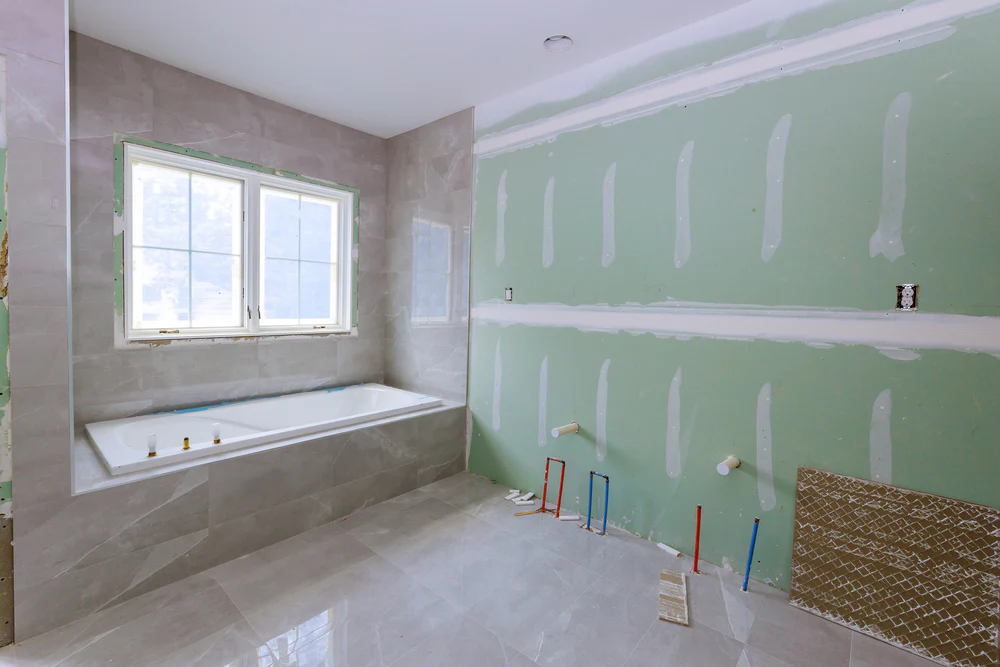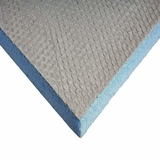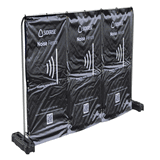- Blogs
- A Comprehensive Guide to Waterproof and Moisture-Resistant Insulation in the UK
A Comprehensive Guide to Waterproof and Moisture-Resistant Insulation in the UK

TLDR: This guide provides a detailed overview of waterproof and moisture-resistant insulation in the UK. While some materials, such as Extruded Polystyrene (XPS) and Polyisocyanurate (PIR), are highly water-resistant due to their closed-cell structure, others like wood fibre and calcium silicate are designed to manage moisture through breathability. The ideal choice of material is highly specific to its application. XPS is often favoured for load-bearing and below-ground projects due to its strength, while PIR is specified for its superior thermal efficiency. Effective installation is paramount and includes proper ventilation and surface preparation. The article also covers the legal and technical standards that govern insulation in the UK, including Building Regulations Part C and L, and British Standards such as BS 5250 and BS 85500.
Introduction: Understanding Waterproof Insulation
Effective moisture management is a fundamental aspect of building design and renovation in the UK's temperate climate. A building's fabric is susceptible to moisture from various sources, including rising damp from the ground, water ingress from rainfall, and condensation that forms within the structure. Failure to control moisture poses significant risks to a building's integrity, including structural damage, and can also have adverse effects on the health of occupants due to the proliferation of mould and other allergens. A primary function of insulation is to create a thermal and moisture barrier that protects a building's core structure.
The term "waterproof" in the context of insulation requires a precise understanding. It is a spectrum of capability rather than a single attribute. Some materials are engineered to be inherently resistant to water absorption, while others are designed to actively manage or permit the passage of moisture in a controlled manner. Selecting the correct material for a specific application depends on this critical distinction. For instance, an underground basement or ground floor requires a material that blocks water, while an older, solid-walled property often benefits from a material that can absorb and release moisture to prevent it from becoming trapped.
Materials and Properties: A Detailed Examination![]()
The selection of an appropriate insulation material is a technical decision based on its properties and the demands of the specific application. Materials can be broadly categorised by their approach to moisture management.
Closed-Cell Rigid Boards
These materials are characterised by a sealed, dense internal structure that minimises water absorption, making them a preferred choice for areas where water exposure is a significant risk.
Extruded Polystyrene (XPS) XPS is a rigid foam insulation board with a closed-cell structure that makes it highly resistant to moisture absorption. Its primary distinguishing feature is its high compressive strength, which allows it to withstand heavy loads without deforming or compacting. This property makes XPS particularly well-suited for load-bearing applications, such as under concrete slabs on ground floors, and on inverted flat roofs and in car parks where the insulation must endure significant weight. The closed-cell nature of XPS also provides high thermal resistance, which effectively reduces heat transfer.
BUY EXTRUDED POLYSTYRENE INSULATION
Polyisocyanurate (PIR) PIR boards are another type of closed-cell foam with a high degree of water resistance. They are generally known for their superior thermal efficiency, with a lower thermal conductivity that allows a thinner layer to provide a comparable level of insulation to other materials. The use of PIR and other closed-cell products has long been advocated for in flood-risk areas because they retain their integrity and dry out quickly after exposure to water, which allows occupants to return to their homes more rapidly. PIR is often the preferred choice when the highest possible thermal performance is the main project objective.
The choice between PIR and XPS is a classic trade-off between thermal performance and physical durability. While PIR offers superior thermal efficiency, XPS is the specialist material for applications where moisture and heavy load are the primary concerns. The two materials are complementary rather than one being universally better than the other, and the correct selection depends entirely on the unique demands of the building project.
Moisture-Regulating Boards
For a building's long-term health, a "breathable" approach to moisture management can sometimes be more appropriate than a completely sealed, impermeable barrier. These materials are designed to actively absorb, store, and release moisture in a controlled manner.
Calcium Silicate Boards Calcium silicate boards are not waterproof but are specifically engineered to actively manage moisture within a building's internal environment. Their porous, vapour-permeable structure absorbs excess humidity from the air and holds it harmlessly within the board. When the internal space dries out, the board releases the stored moisture by evaporation. This process prevents persistent dampness and mould growth and is a proven solution for older, solid-walled properties with damp issues.
Wood Fibre Boards These are natural, vapour-permeable materials that allow for excellent humidity regulation and minimise the risk of condensation. They are often used in "breathable" construction, a method that allows moisture to pass through the building fabric rather than trapping it. Wood fibre boards are suitable for roofs, walls, and floors, and they also offer good thermal performance and acoustic dampening properties. For buildings with solid brick or stone walls, which are common in the UK's heritage buildings, an impermeable barrier can be counterproductive, potentially causing moisture to become trapped and leading to long-term structural damage. In such cases, a moisture-regulating material is a superior solution.
Other Relevant Materials
Other materials are widely used for their thermal properties but require specific treatments or applications to function effectively as part of a moisture-resistant system.
Spray Foam Insulation Closed-cell spray foam insulation is highly resistant to water penetration and creates a monolithic, airtight seal. A key advantage of spray foam is its ability to be applied directly to a breathable membrane without an air gap, a common requirement for some rigid board materials. However, applying spray foam is a serious and often non-reversible modification to a property, and it can make it difficult to inspect the underlying roof structure for issues such as leaks or timber rot.
Fibrous Materials Materials such as mineral wool and fibreglass batts are widely used for thermal and acoustic insulation. However, they are not inherently water-resistant. When these materials become wet, they can lose their thermal effectiveness, slump, and trap moisture, which can lead to permanent damage and require their complete removal. For example, a government-published guide cited by the British Standards Institution (BSI) does not generally recommend mineral fibre batts in flood-risk areas, stating that they can remain wet for several months. Some manufacturers address this vulnerability by adding water-repellent additives to their products to give them the water-resistant properties of a rigid board. This highlights that a seemingly cost-effective choice can be a false economy if not specified correctly for the conditions of a project.
Applications and Best Practices
Insulation is not a standalone product; its effectiveness is dependent on its integration into a complete building assembly. Correct installation is crucial for managing moisture and ensuring long-term performance.
Walls
External Wall Insulation (EWI) EWI systems are one of the most effective ways to improve a home's energy efficiency, particularly for older properties with solid walls. The installation is a methodical process that creates a continuous thermal barrier. It begins with surface preparation and the installation of a starter track, followed by the attachment of insulation boards using adhesive and mechanical fixings. The boards are then covered with a reinforced basecoat and a final render finish. This system protects the building from thermal fluctuation and external moisture.
Internal Wall Insulation For solid walls, internal insulation can be an effective alternative to an EWI system, but proper moisture management is critical. Materials such as calcium silicate boards are specified to actively absorb and manage moisture, preventing condensation and mould growth. An alternative is a system like ISO-THERM, a thin, vapour-permeable, but waterproof material that can be applied directly to a wall to provide insulation and prevent lateral damp transference.
Cavity Walls While materials like Knauf's DriTherm Cavity slabs have a water-repellent additive, the use of closed-cell insulation is recommended for cavity walls in flood-risk areas. The minimal water uptake of closed-cell materials allows them to retain their integrity and dry out quickly following exposure to flood water.
Roofs
The method of insulating a roof fundamentally changes the way a building manages moisture and heat. The two primary approaches are a "cold roof" and a "warm roof."
Pitched Roofs In a traditional "cold roof" assembly, the insulation is laid horizontally at the ceiling level of the top floor. This approach makes the loft space above unheated and requires a minimum 50mm air gap between the insulation and the roof deck with proper eaves and ridge ventilation to prevent condensation. By contrast, a "warm roof" places the insulation at the rafter level, making the roof space part of the heated envelope of the building. This requires continuous airflow beneath the roof membrane and the use of a proper vapour barrier to prevent interstitial condensation from forming on cold surfaces. A key consideration is that changing the insulation from a cold to a warm roof is a serious modification that can make it difficult to identify underlying problems with the timber structure, such as undetected leaks or rot, because it restricts the view from inside the roof space.
Flat and Inverted Roofs UK building regulations generally require flat roofs to be insulated to meet specific U-value targets. Due to their high compressive strength and moisture resistance, materials like XPS are a suitable choice for inverted roofs and those that will be subject to heavy loads, such as a roof terrace or car park.
Floors and Basements
Ground Floors Extruded polystyrene (XPS) boards are suitable for installation under concrete slabs on ground floors due to their strength and moisture resistance. This application minimises heat loss to the ground and enhances thermal comfort.
Damp Proof Courses (DPCs) A damp proof course (DPC) is a legally mandated, engineered barrier installed at the base of a wall to prevent rising damp. Approved Document C of the UK Building Regulations stipulates that a DPC must be at least 150mm above the adjacent ground level. The installation of a DPC is a prerequisite for any further insulation to be effective, as insulation will not solve a problem caused by rising damp.
UK Standards and Regulations ![]()
The UK's regulatory framework directly links moisture control and insulation to a building's durability and the health and safety of its occupants.
UK Building Regulations
-
Approved Document C: This document provides guidance on resistance to moisture and contaminants. It mandates that floors, walls, and roofs are constructed to protect the building and its occupants from the harmful effects of moisture, including rising damp, precipitation, and condensation. Approved Document C legally requires the installation of a DPC in new construction and during certain types of renovation. A failure to manage moisture is not merely a building maintenance issue but a public health and legal concern, as moisture-related problems like mould can lead to health risks such as asthma and allergic reactions.
-
Approved Document L: This part of the regulations covers the conservation of fuel and power. It sets specific U-value targets for different building elements, with a lower U-value indicating a better insulating performance. All insulation products must be installed to meet or exceed these regulatory targets.
British Standards (BS)
-
BS 5250: Code of Practice for Control of Condensation: This standard provides guidelines for managing condensation and water penetration in buildings. The 2021 revision broadened its scope from a focus on condensation to all sources of moisture, including rising damp and rain penetration, and also takes into account the effects of modern building methods and climate change.
-
BS 85500: Guide to Flood-Resistant and Resilient Construction: This guide recommends the use of closed-cell insulation products as the material of choice for flood resilience. This is due to their minimal water uptake and their ability to retain integrity when exposed to flood water.
Selecting the Right Solution
The selection of insulation is a nuanced decision. It is not about finding a single "best" material but rather identifying the most appropriate material for the specific application, considering the nature of the building and the project's overall goals. A fundamental understanding of material properties is paramount to avoiding costly mistakes. A professional homeowner or building professional should consider both the initial material cost and the long-term strategic value of the insulation in the context of the entire building assembly. For example, the choice of a material that is vulnerable to moisture could lead to a costly and disruptive replacement project down the line.
A comparison of key waterproof and water-resistant insulation materials is provided below to assist with the decision-making process.
Comparison of Key Waterproof and Water-Resistant Insulation Materials
| Material Type | Water Resistance | Key Benefit | Typical UK Applications |
| PIR (Polyisocyanurate) | High | Excellent thermal performance | Walls, pitched and flat roofs, floors |
| XPS (Extruded Polystyrene) | Very High | High compressive strength | Inverted roofs, ground floors, basements |
| Calcium Silicate Boards | Vapour Permeable | Active moisture absorption, mould control | Damp internal walls and basements |
| Wood Fibre Boards | Vapour Permeable | Breathability, humidity regulation | Walls and roofs in breathable construction |
| Mineral Wool (treated) | Water Repellent | Fire resistance, acoustic dampening | Cavity walls, lofts |
Legal Disclaimer
This content is for informational purposes only. The information provided is a general guide and does not constitute professional advice. All building and renovation projects should be thoroughly checked against current UK Building Regulations and British Standards. It is essential to consult with a qualified professional, such as a chartered surveyor, architect, or structural engineer, before specifying any materials or commencing work. This content should not be used for material specification.

Samuel Hitch
Managing Director
Buy Insulation Online.
Leave A Reply
Your feedback is greatly appreciated, please comment on our content below. Your email address will not be published. Required fields are marked *
















































































































































































































































































































































































































































